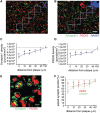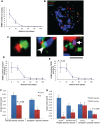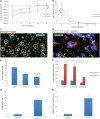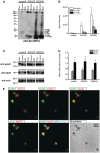Apolipoprotein E4 effects in Alzheimer's disease are mediated by synaptotoxic oligomeric amyloid-β
- PMID: 22637583
- PMCID: PMC3381721
- DOI: 10.1093/brain/aws127
Apolipoprotein E4 effects in Alzheimer's disease are mediated by synaptotoxic oligomeric amyloid-β
Abstract
The apolipoprotein E ε4 gene is the most important genetic risk factor for sporadic Alzheimer's disease, but the link between this gene and neurodegeneration remains unclear. Using array tomography, we analysed >50000 synapses in brains of 11 patients with Alzheimer's disease and five non-demented control subjects and found that synapse loss around senile plaques in Alzheimer's disease correlates with the burden of oligomeric amyloid-β in the neuropil and that this synaptotoxic oligomerized peptide is present at a subset of synapses. Further analysis reveals apolipoprotein E ε4 patients with Alzheimer's disease have significantly higher oligomeric amyloid-β burden and exacerbated synapse loss around plaques compared with apolipoprotein E ε3 patients. Apolipoprotein E4 protein colocalizes with oligomeric amyloid-β and enhances synaptic localization of oligomeric amyloid-β by >5-fold. Biochemical characterization shows that the amyloid-β enriched at synapses by apolipoprotein E4 includes sodium dodecyl sulphate-stable dimers and trimers. In mouse primary neuronal culture, lipidated apolipoprotein E4 enhances oligomeric amyloid-β association with synapses via a mechanism involving apolipoprotein E receptors. Together, these data suggest that apolipoprotein E4 is a co-factor that enhances the toxicity of oligomeric amyloid-β both by increasing its levels and directing it to synapses, providing a link between apolipoprotein E ε4 genotype and synapse loss, a major correlate of cognitive decline in Alzheimer's disease.
Figures






Comment in
-
Neurodegenerative disease: Insights into synaptotoxicity in AD.Nat Rev Neurol. 2012 Jun 19;8(7):357. doi: 10.1038/nrneurol.2012.121. Nat Rev Neurol. 2012. PMID: 22710622 No abstract available.
Similar articles
-
Apolipoprotein E, especially apolipoprotein E4, increases the oligomerization of amyloid β peptide.J Neurosci. 2012 Oct 24;32(43):15181-92. doi: 10.1523/JNEUROSCI.1542-12.2012. J Neurosci. 2012. PMID: 23100439 Free PMC article.
-
Apolipoprotein E ε4 and ε3 alleles associate with cerebrospinal fluid tau and cognition in the presence of amyloid-β in mild cognitive impairment but not in Alzheimer's disease.J Integr Neurosci. 2021 Jun 30;20(2):277-286. doi: 10.31083/j.jin2002027. J Integr Neurosci. 2021. PMID: 34258926
-
Oligomeric amyloid beta associates with postsynaptic densities and correlates with excitatory synapse loss near senile plaques.Proc Natl Acad Sci U S A. 2009 Mar 10;106(10):4012-7. doi: 10.1073/pnas.0811698106. Epub 2009 Feb 19. Proc Natl Acad Sci U S A. 2009. PMID: 19228947 Free PMC article.
-
Apolipoprotein E isoforms in Alzheimer's disease pathology and etiology.Microsc Res Tech. 2000 Aug 15;50(4):278-81. doi: 10.1002/1097-0029(20000815)50:4<278::AID-JEMT5>3.0.CO;2-T. Microsc Res Tech. 2000. PMID: 10936880 Review.
-
The genetics of Alzheimer's disease.Am J Alzheimers Dis Other Demen. 2007 Feb-Mar;22(1):37-41. doi: 10.1177/1533317506295655. Am J Alzheimers Dis Other Demen. 2007. PMID: 17534000 Free PMC article. Review.
Cited by
-
Synaptopathies: synaptic dysfunction in neurological disorders - A review from students to students.J Neurochem. 2016 Sep;138(6):785-805. doi: 10.1111/jnc.13713. Epub 2016 Sep 8. J Neurochem. 2016. PMID: 27333343 Free PMC article. Review.
-
Effect of apolipoprotein E genotype and diet on apolipoprotein E lipidation and amyloid peptides: randomized clinical trial.JAMA Neurol. 2013 Aug;70(8):972-80. doi: 10.1001/jamaneurol.2013.396. JAMA Neurol. 2013. PMID: 23779114 Free PMC article. Clinical Trial.
-
The duality of amyloid-β: its role in normal and Alzheimer's disease states.Mol Brain. 2024 Jul 17;17(1):44. doi: 10.1186/s13041-024-01118-1. Mol Brain. 2024. PMID: 39020435 Free PMC article. Review.
-
Greater medial temporal hypometabolism and lower cortical amyloid burden in ApoE4-positive AD patients.J Neurol Neurosurg Psychiatry. 2014 Mar;85(3):266-73. doi: 10.1136/jnnp-2013-305858. Epub 2013 Aug 21. J Neurol Neurosurg Psychiatry. 2014. PMID: 23965289 Free PMC article.
-
APOE-amyloid interaction: Therapeutic targets.Neurobiol Dis. 2020 May;138:104784. doi: 10.1016/j.nbd.2020.104784. Epub 2020 Feb 4. Neurobiol Dis. 2020. PMID: 32027932 Free PMC article. Review.
References
-
- Bellosta S, Nathan BP, Orth M, Dong LM, Mahley RW, Pitas RE. Stable expression and secretion of apolipoproteins E3 and E4 in mouse neuroblastoma cells produces differential effects on neurite outgrowth. J Biol Chem. 1995;270:27063–71. - PubMed
-
- Chartier-Harlin MC, Parfitt M, Legrain S, Perez-Tur J, Brousseau T, Evans A, et al. Apolipoprotein E, epsilon 4 allele as a major risk factor for sporadic early and late-onset forms of Alzheimer's disease: analysis of the 19q13.2 chromosomal region. Hum Mol Genet. 1994;3:569–74. - PubMed
-
- Cleary JP, Walsh DM, Hofmeister JJ, Shankar GM, Kuskowski MA, Selkoe DJ, et al. Natural oligomers of the amyloid-beta protein specifically disrupt cognitive function. Nat Neurosci. 2005;8:79–84. - PubMed
Publication types
MeSH terms
Substances
Grants and funding
LinkOut - more resources
Full Text Sources
Other Literature Sources
Medical
Molecular Biology Databases

